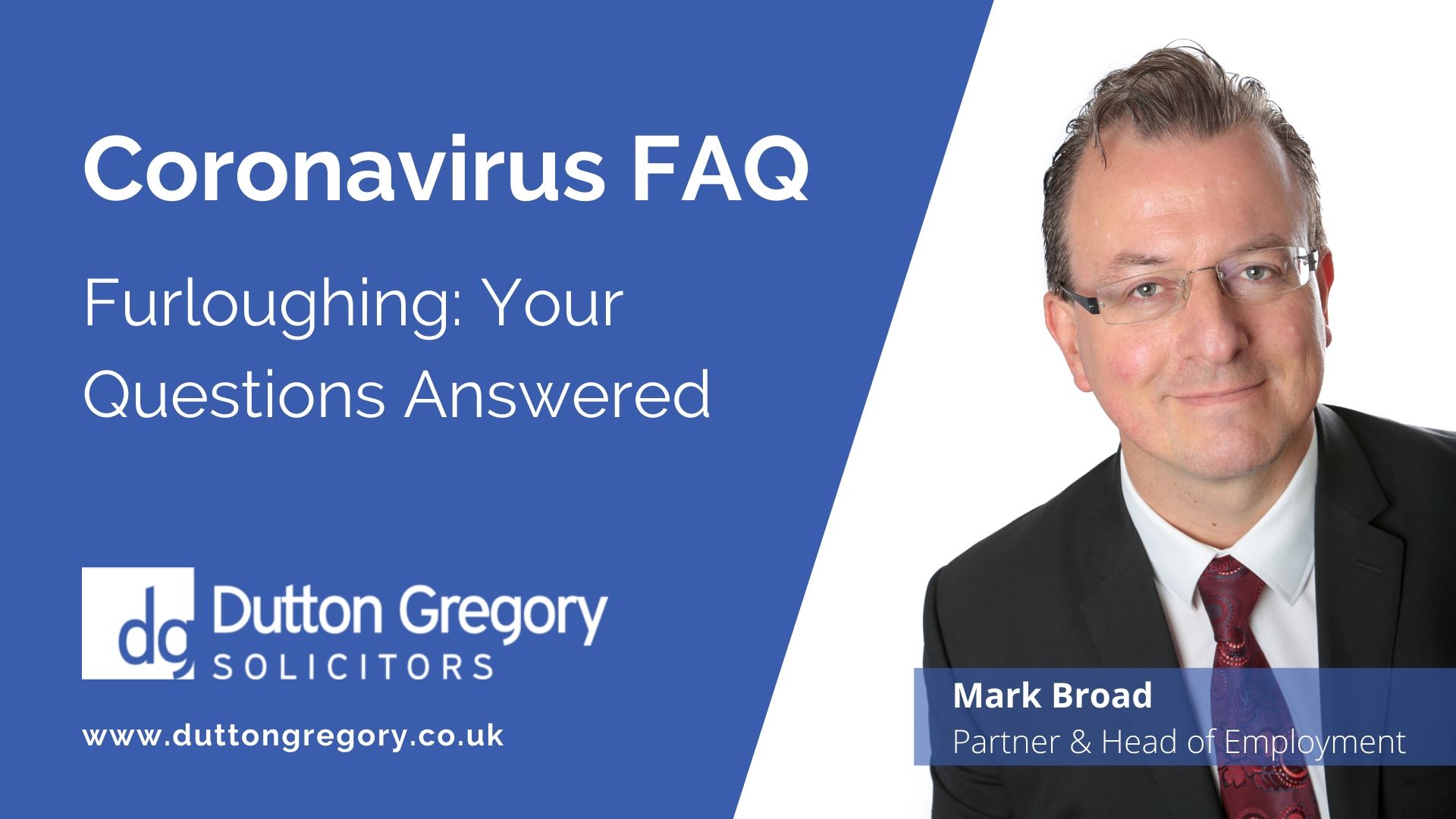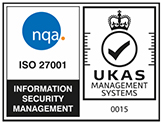Furloughing is the latest focal point in employment law but what is it and what does it mean for both employers and employees? Partner and Head of Employment Mark Broad answers some of the most common questions around this topic.
UPDATE (17/04/2020): The Chancellor has extended the Coronavirus Job Rention (furlough) Scheme by one month, to the end of June, to reflect the continuation of social distancing measures. Click here for the latest government guidance. Additional advice will be provided in this article in due course.
Please note: This is a general summary of what we know so far and should not be taken as legal or accountancy advice. Guidance and opinion can change daily, so please seek specific advice before taking any steps. Call our Employment team if you require quick and up-to-date guidance.
Section 1: Interpretation
- What does ‘furloughing’ mean?
- Is furloughing the same as the Government Job Retention Scheme?
- Is the scheme open to any employer?
- Can anyone be furloughed?
Section 2: Payments
- Does the £2500 grant include overtime or commission and the like?
- Do employers have to top up the employee’s salary above the 80% rebate from the government?
- Do employers still have to pay their National Insurance?
- Do employers still have to make pension contributions?
- What if the 80% brings the employee down below the minimum wage?
- How does an employer apply for the grant?
- What do employers need in order to make a claim for the grant?
- Is the furlough grant taxable?
Section 3: How and when
- Can we furlough in any circumstances?
- Does it matter how many people are furloughed?
- What if the employee does not agree to be furloughed?
- Can the employee still do some work for the employer?
- Does the employer have to have started a redundancy process to be able to claim?
- How do employers decide who is to be furloughed?
- When making this selection, can employers take into account individual circumstances such as the ability to work from home?
Section 4: Special cases
- Can employers furlough self-isolating and sick employees?
- Can employers furlough employees on unpaid leave?
- Can employees be asked to take holiday during furlough?
- Can the employer furlough those on long-term sick?
- Can employers bring employees back off furlough, and then furlough them again?
- Would an employee be ‘unfairly dismissed’ if furloughing is not considered?
- What about employees on the different types of statutory leave?
- Can employees be made redundant after furloughed?
Section 5: Contractual matters
- Do we need the employee’s agreement to furlough?
- Should employers have a furloughing agreement with employees?
- Who can employers call for advice?
Section 1: Interpretation
What does ‘furloughing’ mean?
It means sending home an employee when there is not enough work to do, with a guaranteed payment, until such time as there is enough work. It is common in the USA, but a new concept to the UK.
Is furloughing the same as the Government Job Retention Scheme?
Yes. If an employer had a PAYE payroll running on 28 February 2020, then it can furlough employees under the Government scheme.
This is currently between 1 March 2020 and 31 May 2020 (with a possible extension) for employees who were on the payroll at the start. It is for a period of a minimum of three weeks either as a result of there being is no work for them, or because their employer is unable to operate due to the impact of coronavirus;
The government will pay grants to employers representing 80% of the employees’ wages, capped at £2,500 a month with income tax and employee's NI is payable in the usual way.
Is the scheme open to any employer?
Almost. It’s open to businesses, charities, recruitment agencies where their agency workers are paid through PAYE and public authorities.
However, if an organisation receives public funding for staff already, then it is expected to use that money to continue to pay employees and not furlough them.
Can anyone be furloughed?
Mostly, yes. Full-time and part time employees, employees on agency contracts (who are not working) and employees on flexible or zero hours contracts. Not the self-employed of course. There is a different scheme for them.
Section 2: Payments
Does the £2500 grant include overtime or commission and the like?
No. For employees whose pay does not vary, they receive their base salary excluding commission and bonuses. For those whose pay varies, they receive the same earnings as the same period in the previous year; or their average earnings in the 2019-20 tax year.
Do employers have to top up the employee’s salary above the 80% rebate from the government?
No. The employer must pay to employees, at least, the amount of the grant it receives under the scheme. There is no obligation to top up. But employers will then be paying less than required by most employee contracts, so there might be employment law issues to contend with.
Do employers still have to pay their National Insurance?
Yes, but this can be claimed back as well.
Do employers still have to make pension contributions?
Some will do. However, they may wish to agree to have a pension ‘holiday’ so that the employee is not paying, and therefore neither is the employer (other than the employer’s statutory 3%). It’s also worth noting that minimum auto-enrolment contribution can be claimed back, leaving the employee has a little more cash in their pocket and the employer with less cost.
What if the 80% brings the employee down below the minimum wage?
As they will not be working, this is probably not a problem. However, if the employee is carrying out training whilst furloughed, they must receive minimum wage.
How does an employer apply for the grant?
The HMRC online portal has been promised by the end of April. Employers will have to self certify that they have furloughed employees. Employers will probably be audited at some point in the future so it is advised to keep all evidence of business difficulties such as downturn in turnover and cash flow issues, in case it is requested in the months and years to come.
What do employers need in order to make a claim for the grant?
Probably, at least the following:
- the ePAYE reference number;
- the number of employees being furloughed;
- the claim period (start and end date);
- amount claimed per the minimum length of furloughing;
- employer’s bank account number and sort code;
- contact name;
- phone number.
Employers can claim every three weeks and the money will be paid via BACS to the employer, not the employee.
Is the furlough grant taxable?
Yes, payments received by the employer offset payroll costs and must be shown as income in accordance with normal principles.
Section 3: How and when
Can we furlough in any circumstances?
This is a job retention scheme, and so employers can only furlough an employee where there is no work for them or the business is unable to operate because of the coronavirus pandemic.
Does it matter how many people are furloughed?
Maybe. If an employer is varying the contracts of 20 or more employees, then collective consultation rules might apply and employers might have to consult with unions or, if none, elected employee representatives and file an HR1 form with the government. However, this is currently a grey area. There is debate around whether a furlough represents an intention to make redundancies, which might simply be a timing issue for many. Always seek professional advice.
What if the employee does not agree to be furloughed?
If the employee does not agree then the employer might proceed with a redundancy process, considering all alternatives to redundancy before making a final decision.
Can the employee still do some work for the employer?
No, the employee must not work. They cannot work on reduced hours, for reduced pay, or any other variation. They may only volunteer elsewhere or train during this period.
Does the employer have to have started a redundancy process to be able to claim?
No. But the employer should keep any evidence which suggests that but, for the furlough scheme, redundancies would have been probable.
How do employers decide who is to be furloughed?
If the employer has a group of people who all do the same job and only requires some of them, then it will have to apply a fair and reasonable selection criteria in deciding who stays and who is furloughed, as well as consider the skills needed for the business during the furlough period.
When making this selection, can employers take into account individual circumstances such as the ability to work from home?
This would be a reasonable consideration however, be careful not to generalise or make stereotypical assumptions which might be discriminatory.
Section 4: Special Cases
Can employers furlough self-isolating and sick employees?
The guidance suggests that those employees who are ‘shielding’ others in their household (for good reason) can be furloughed. Those who are self-isolating, or on sick leave, receive just SSP. Employers can claim the first 14 days SSP back from the government.
Can employers furlough employees on unpaid leave?
Usually, no, because in such circumstances the normal contractual pay is zero and employers cannot claim back more than 80% of the contractual pay. However, if employees have been laid off with no or low pay, they can probably be furloughed under the scheme.
Can employees be asked to take holiday during furlough?
Probably, however this raises the question as to what to pay them. An employer could furlough an employee for three weeks, then require them to take a week's holiday, and then furlough them again for three weeks. And when on holiday, it is probably the case that the employee should receive their full contractual pay, and not any lesser amount that they are paid on furlough. It is always best to take advice on specific circumstances.
Can the employer furlough those on long-term sick?
Those on sick leave should be paid at least SSP. Once fit for work, they can be furloughed
Can employers bring employees back off furlough, and then furlough them again?
Furloughing must be for a minimum of three weeks however, as long as that minimum period is respected, it seems to be the case that some flexibility is expected from the government on employee movements to meet business demands. As ever, always keep evidence of the business needs.
Would an employee be ‘unfairly dismissed’ if furloughing is not considered?
Probably. Employers are obliged to do everything reasonably possible to avoid redundancies and furloughing is an obvious option.
What about employees on the different types of statutory leave?
If a pregnant woman is furloughed, then calculation of her maternity pay might be based on her earnings in that period, which might be less than normal. If an employer pays enhanced pay to those on maternity, shared parental, adoption or paternity pay, then this enhanced amount is the basis upon which the employer can claim back under the scheme. Of course, employees cannot be forced to take holiday during this period.
Can employees be made redundant after furloughed?
Yes, subject to the usual rules, processes and consultation.
Section 5: Contractual Matters
Do we need the employee’s agreement to furlough?
Check the employment contract. Some contracts have clauses which allow you to send employees home with, or without, pay if you do not have enough work. These are called ‘lay off’ clauses and are more often found in unionised industries. If there is such a clause, employers do not need employee’s consent to furlough them. Otherwise, an agreement must be reached. We expect most employees faced with redundancy or a guaranteed payment are more likely to agree to the latter and furlough.
Should employers have a furloughing agreement with employees?
Yes, ideally as it is useful evidence. It might include:
- the employee’s agreement to be furloughed;
- confirmation of when the furlough starts;
- if the employee has been made redundant, agreement that the redundancy has been withdrawn and that redundancy pay and pay in lieu of notice will be repaid;
- how the employer can or will end the furlough;
- that the employee will not be required or allowed to carry out any work for the employer;
- that the employee can volunteer or do some training;
- what the employee will be paid;
- if relevant, agreement by the employee to accept less than contractual pay;
- agreement that they will be treated as using up holiday during the furlough period;
- that statutory rights e.g. maternity, shared parental or adoption leave and pay, will continue;
- assurance that employer has up-to-date contact details for the employee and asking the employee to remain contactable;
- reserving the right for the employer to make changes to the scheme;
- confirmation that all other terms of the contract of employment remain in force.
Who can employers call for advice?
Please call any of our offices and ask for the Employment team for any advice or support. We will be happy to help and will be offering cost-free a quick steer on these issues, for the duration of the furlough scheme.








